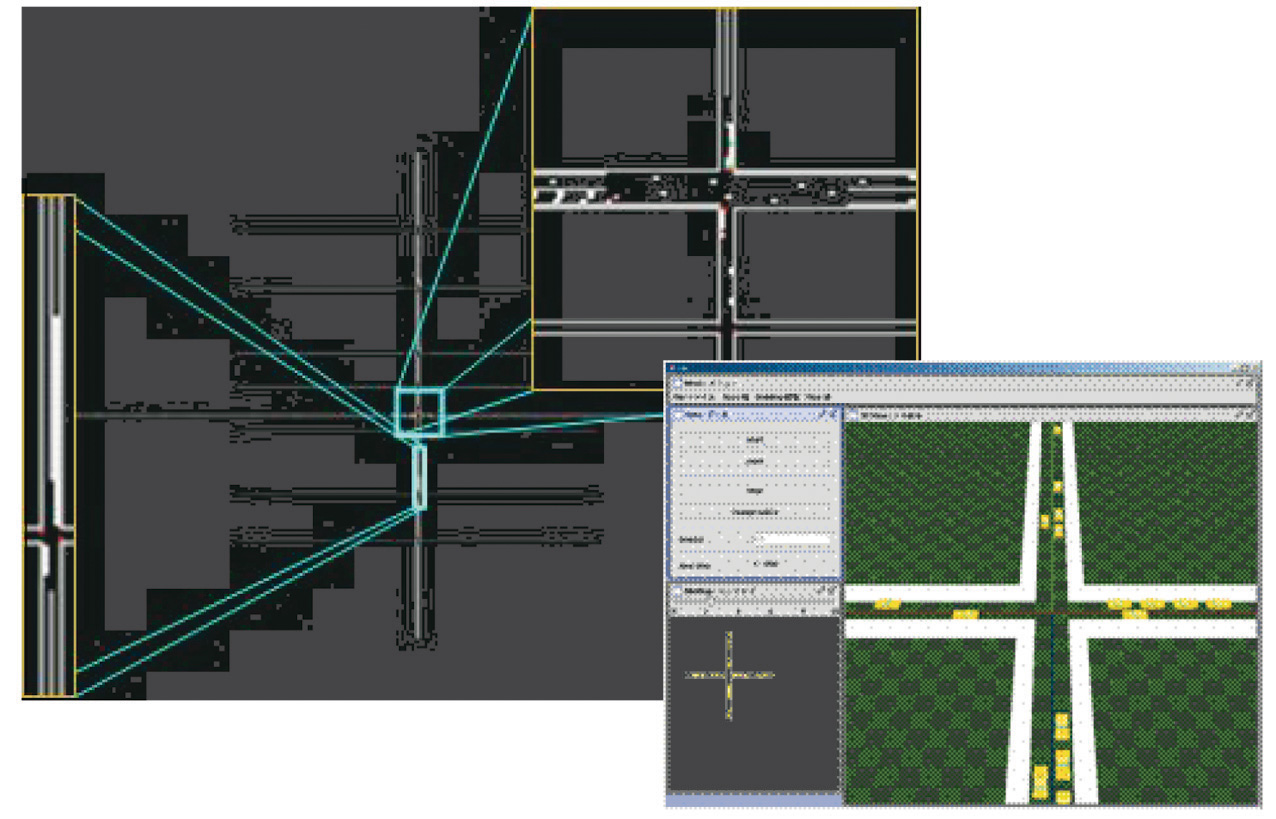Comprehensive List of Researchers "Information Knowledge"
Department of Complex Systems Science
- Name
- KITA, Eisuke
- Group
- Emergent Systems Group
- Title
- Professor
- Degree
- Dr. of Engineering
- Research Field
- Computer science / Multi-agent system / Social system / Bayesian network

Current Research
Computer Simulations for Natural and Social Systems
OUTLINEOur research projects are computer simulations on physical and social problems. They are mainly categorized into four topics : traffic flow simulation models, financial market simulations based on multi-agent systems and evolutionary computing. We are also studying numerical analysis schemes, parallel algorithms, and so on.
TOPICS
(1) Traffic Flow Simulation Model
Since controlling vehicle velocity fluctuation is very important, we developed a stochastic velocity model in which velocity and vehicle movement are controlled based on uniform random numbers. In the model, rules for controlling vehicle behaviors may be simpler than previous models. The model has been applied to the traffic flow simulation on highways and in the city of Nagoya. Results were compared with actual traffic data. Next, the simulation model was applied to traffic flow through an electric toll gate and a road construction zone.
(2) Financial Market Simulation
In traditional market models, an efficient market hypothesis is assumed. In the hypothesis, financial markets are considered to be"efficient,"or prices on traded assets already reflect all known information. However, studies of actual market data show several anomalies that cannot be predicted by hypothesis. So a behavioral finance theory has been presented. Behavioral finance is the study of investor behavior and its effects on markets. We are studying the effect of dealing behavior based on a behavioral finance theory on the stock market by using a multi-agent system simulation.
(3) Evolutionary Computing
We focus on stochastic schemata exploiter (SSE), which is an evolutionary optimization algorithm for solving combinatorial optimization problems. SSE has faster convergence properties than genetic algorithms ; however, the performance of SSE to find a global optimum is weak. So, we improved the SSE algorithm by changing the generation alternation algorithm.
(4) Numerical Analysis Schemes
We are studying the algorithms and applications of numerical analysis schemes by focusing on boundary element (BEM) and Trefftz methods. We have presented the following : a shape optimization algorithm by BEM, an adaptive boundary element method, the basic technologies of user-friendly and robust natural language systems, design sensitivity analysis by the Trefftz method, an adaptive Trefftz method, so on.
(5) Bayesian Network and Web service
We are studying the application of Bayesian network to the prediction of the consumer behavior. The results are applied to web service and the prediction of the stock market behavior.
FUTURE WORK
In traffic flow simulation model, we study traffic behavior models and the psychological biases of drivers. After that, we will develop mathematical models for traffic accidents. In financial market simulations, we are currently concentrating on models for psychological biases alone. We plan to incorporate studies of other biases. In evolutionary computation, we are studying the combination of genetic algorithms and self-organizing maps (SOM). In numerical analysis schemes, we plan to study an element-free solution based on the Trefftz method. In bayesian network, we plan to study its application to web service and trend analysis of stock market.

Figure : Traffic flow simulation
Career
- Eisuke Kita received a Dr. of Engineering degree in Mechanical Engineering from Nagoya University in 1991.
- He was an assistant professor at Nagoya University from 1991-1998.
- He was an assistant professor at Nagoya University from 1991-1998 and an associate professor from 1999 to 2002.
- He was an associate professor from 1999 to 2002.
- Since 2004, he has been on the faculty of the Graduate School of Information Science at Nagoya University.
- Since 2009, he is a professor of the Graduate School of Information Science at Nagoya University.
Academic Societies
- The Institute of Electrical and Electronics Engineers
- Information Processing Society of Japan (IPSJ)
- Japan Society of Mechanical Engineering (JSME)
- Japan Society of Industrial and Applied Mathematics (JSIAM)
- Japan Society of Computational Engineering and Science (JSCES)
- Japan Society for Fuzzy Theory and Intelligent Informatics (SOFT)
- The Institute of Electronics, Information and Communication Engineers (IEICE)
- International Society of Boundary Elements (ISBE)
- Japan Society of Artificial IIntelligence
- International Society for Structural and Multidisciplinary Optimization
Publications
- Cellular Automata in Excel
- Utility Analysis of Zipper-Merging for Improvement of Traffic Jam by CA Simulation, Journal of Technical Physics, Vol.L, No.4, 387-402, 2011.
- Effect of Overconfident Investor Behavior to Stock Market, Journal of Advanced Computational Intelligence and Intelligent Informatics, Vol. 14 No.6, pp.661-668, 2010.07.15.
- Application of Advanced Grammatical Evolution to Function Prediction Problem, Advances in Engineering Software, Vol.41, pp.1287-1294, 20010.10.08.
- Investigation of Self-Organizing Map for Genetic Algorithm, Advances in Engineering Software, Vo.41, No.2, 148-153, 2010.02.
- Influence of Investors’ Loss-Cut Behavior to Artificial Market, Evolutionary and Institutional Economics Review, Vol.7, No.1, 133-153, 2010.12.
- Stock Prices Prediction by Using Bayesian Network, Transaction of IPSJ, Vol.3(SIG), No.3, 80-90, 2010.10.
- Improvement of Traffic Jam at Merging Point of Roads by Using Multi-Car-Following Model, Journal of JSME, Vol.75, No.758, C, pp. 695-2702, 2009.9.
- Swap Contract for Risk Hedge of Fish Price, Transaction of IPSJ, Vol.2, No.3, pp.138-145 , 2009.12.
- Traffic Flow Simulation on a Freeway Using Cellular Automata, Transaction of IPSJ, Vol.46, No.SIG10(TOM12), 30-40, 2005
- Handbook of Structural Engineering, Kyoritsu-shuppan, 2004.








